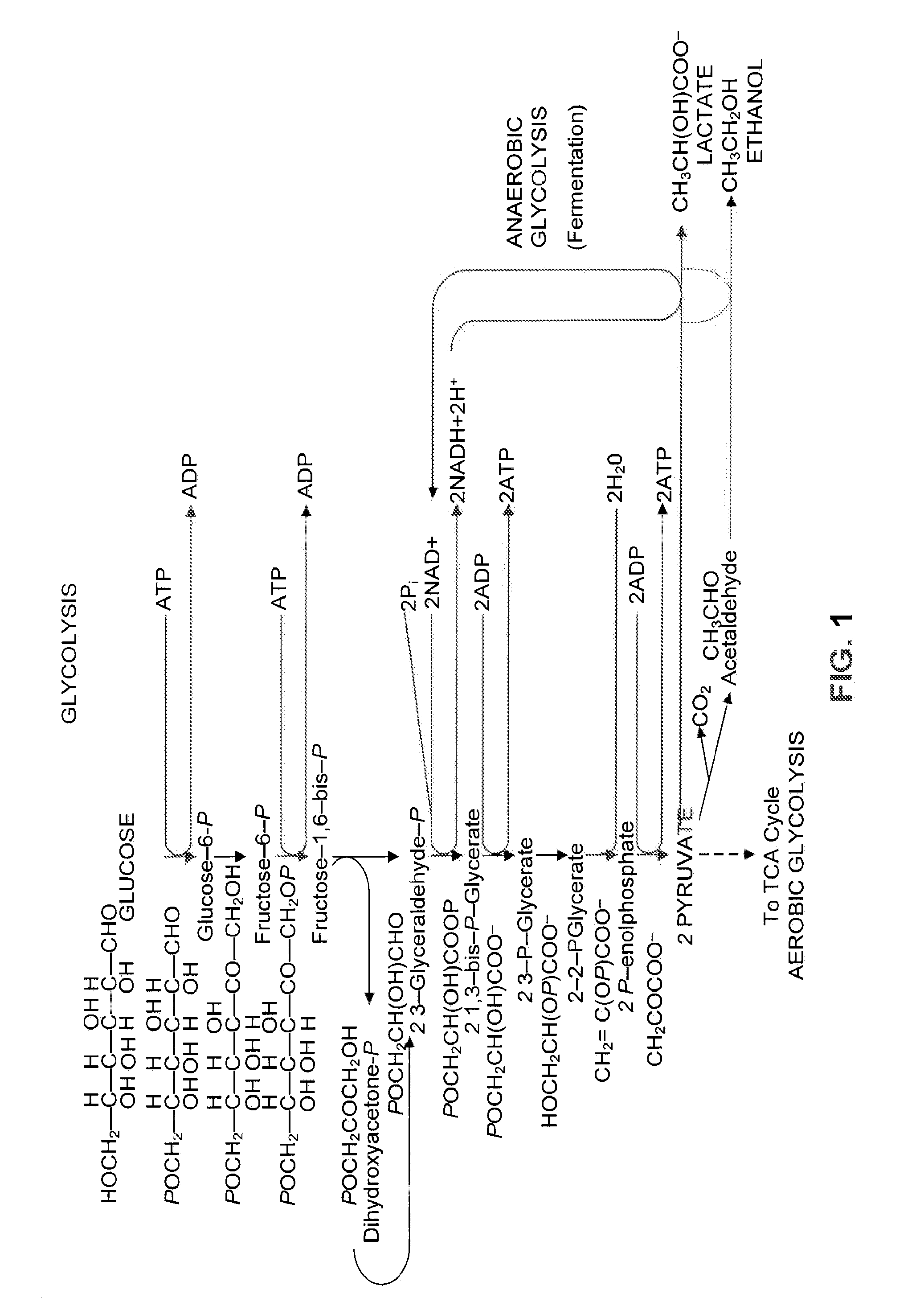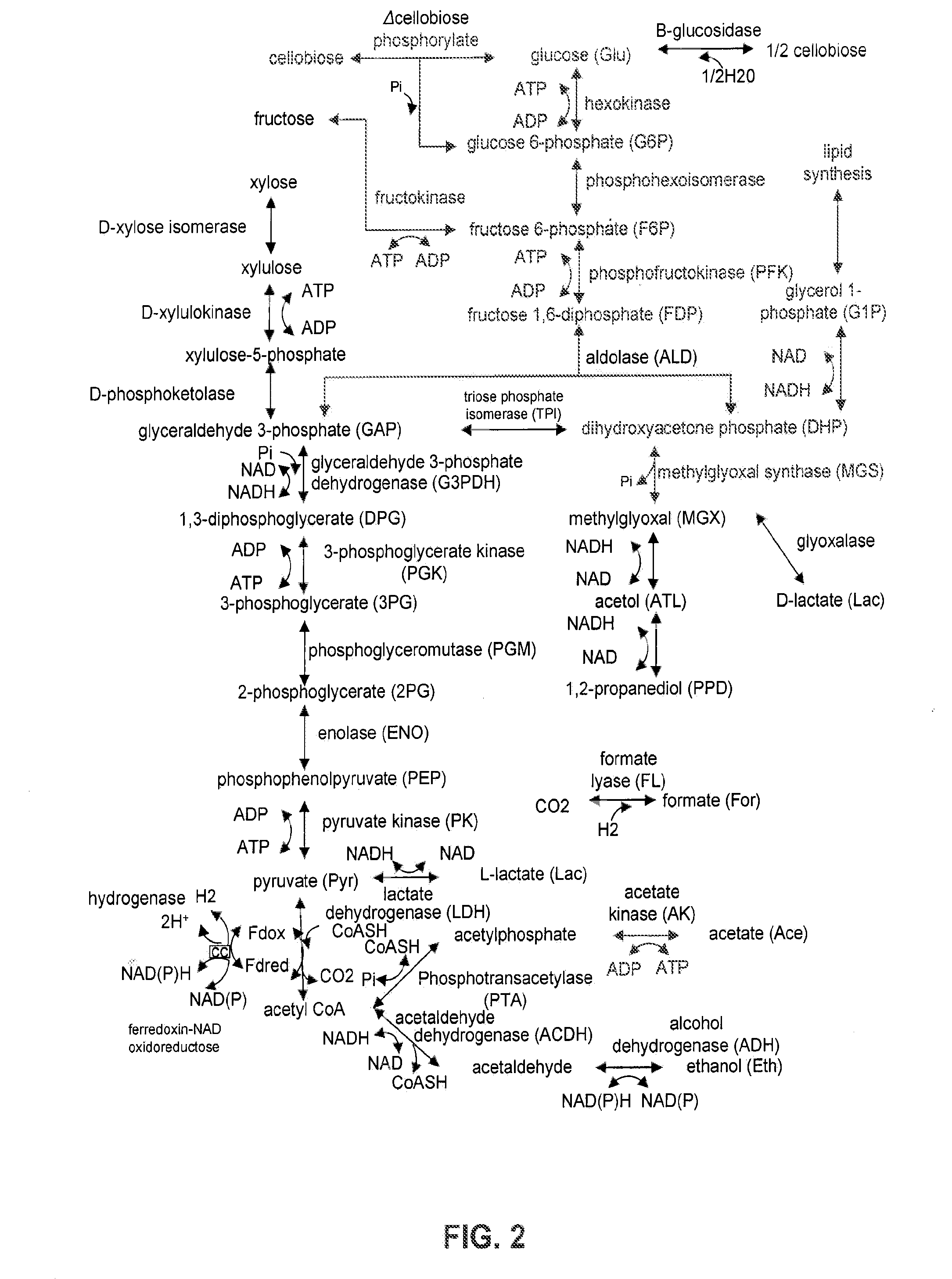Detoxification of Biomass Derived Acetate Via Metabolic Conversion to Ethanol, Acetone, Isopropanol, or Ethyl Acetate
a technology metabolic conversion, which is applied in the field of detoxification of biomass derived acetate, can solve the problems of limiting the cellular energy that can be directed, the absence of low-cost technology for overcoming the recalcitrance of these materials, and the historically proven problem of hydrolysis, so as to improve the tolerance and robustness of growth
- Summary
- Abstract
- Description
- Claims
- Application Information
AI Technical Summary
Benefits of technology
Problems solved by technology
Method used
Image
Examples
example 1
Detoxification of Lignocellulosic Material Through In Vivo Uptake of Acetate and Formation of Ethanol
[0240]Acetate is a major inhibitor of cellular growth and is present in large quantities in biomass derived substrates. During the conversion of lignocellulosic materials into ethanol, a large portion of cellular energy must be spent to avoid the harmful effects of acetic acid. Because of these effects, cellular growth and other important phenotypes are decreased resulting in a sub-optimal process.
[0241]In order to overcome the inhibitory effects of acetate, it is desired to convert the acetate from an inhibitory compound into a less inhibitory compound, e.g., ethanol, that is also the primary product produced during yeast fermentation. Attempts to overcome the inhibitory effects of acetate have relied upon endogenous gene activity for the conversion of acetate to acetyl-CoA, a metabolic intermediate prior to ethanol formation, without success. It has recently been shown that a glyce...
example 2
Detoxification of Biomass Derived Acetate Via Metabolic Conversion to Acetone, Isopropanol, or Ethyl Acetate
[0251]As described herein, acetic acid is an unavoidable product of pretreatment and hydrolysis, and very harmful to fermenting organisms, especially at the industrially relevant pH range of 4-5. Removal of acetic acid prior to fermentation by chemical or physical methods is either prohibitively expensive or results in lost sugar yield (washing). By engineering a pathway to convert acetic acid to acetone, isopropanol, or ethyl acetate in ethanol producing organisms, acetic acid toxicity can be lowered and an easily recovered co-product can be produced. In addition, conversion of acetate to a solvent will lower the demand for base addition, lowering the overall fermentation cost and making pH control more manageable and robust. Such considerations become especially important at industrial scale. Further, removal of acetate will lower the amount of organic compounds sent for was...
example 3
Engineering of Yeast Strains with Improved Tolerance to Acetate and Other CBP By-Products
[0285]As described herein, a large portion of cellular energy must be spent to avoid the harmful effects of acetic acid during the conversion of lignocellulosic materials into ethanol. Because of these effects, cellular growth and other important phenotypes are decreased resulting in a sub-optimal process. Additional acidic and other organic by-products, including aldehydes, can also add to sub-optimal processing of lignocellulosic materials.
[0286]The present invention describes various engineered pathways for overcoming the inhibitory effects of biomass inhibitors, including but not limited to, acetate and other CBP by-products, by converting the acetate into a less inhibitory compound, such as those described herein. To improve the ability of yeast strains to grow in the presence of a biomass inhibitor, yeast strains were engineered that have increased growth tolerance to biomass inhibitors.
1)...
PUM
| Property | Measurement | Unit |
|---|---|---|
| temperature | aaaaa | aaaaa |
| temperature | aaaaa | aaaaa |
| resistance | aaaaa | aaaaa |
Abstract
Description
Claims
Application Information
 Login to View More
Login to View More - R&D
- Intellectual Property
- Life Sciences
- Materials
- Tech Scout
- Unparalleled Data Quality
- Higher Quality Content
- 60% Fewer Hallucinations
Browse by: Latest US Patents, China's latest patents, Technical Efficacy Thesaurus, Application Domain, Technology Topic, Popular Technical Reports.
© 2025 PatSnap. All rights reserved.Legal|Privacy policy|Modern Slavery Act Transparency Statement|Sitemap|About US| Contact US: help@patsnap.com



